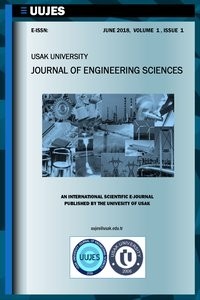EFFECTS OF FILLING RATIO, ORIENTATION AND PRINT TEMPERATURE ON BENDING PROPERTIES OF 3D PRINTED PLA BEAMS
EFFECTS OF FILLING RATIO, ORIENTATION AND PRINT TEMPERATURE ON BENDING PROPERTIES OF 3D PRINTED PLA BEAMS
In this study, flexural properties of 3D printed PLA beam specimens produced with different filling ratios, orientations and print temperatures are experimentally investigated. Various bending specimens were produced by means of 3D printer using PLA filament as raw material. Low, intermediate and high filling ratios, lengthwise/widthwise and crosswise filling orientations, and different print temperatures were chosen as alternative production parameters of the printer. Manufactured beam specimens were subjected to three-point bending tests at room temperature in accordance with the TS EN ISO 178 standard. Effects of production parameters on mechanical bending properties including flexural modulus, maximum flexural stress, flexural strain at break, maximum force, and maximum deflection are clearly shown and discussed to state reasonable explanations of test results and to make conclusive suggestions.
Keywords:
3D printed PLA beams, flexural beam properties, filling ratio effects orientation effects, temperature effects,
___
- 1. Hernandez R, Slaughter D, Whaley D, Tate J and Asiabanpour B. Analyzing the tensile, compressive, and flexural properties of 3D printed ABS P430 plastic based on printing orientation using fused deposition modeling. In: Bourell DL. Solid Freeform Fabrication 2016: Proceedings of the 26th Annual International Solid Freeform Fabrication Symposium – An Additive Manufacturing Conference; 2016 Aug 7-10; USA, Texas, Austin: The University of Texas at Austin; 2016. p. 939-950.
- 2. Cantrell J, Rohde S, Damiani D, Gurnani R, DiSandro L, Anton J, Young A, et al. Experimental characterization of the mechanical properties of 3D-printed ABS and polycarbonate parts. Rapid Prototyping Journal, 2017;23(4):811-824.
- 3. Kim H, Park E, Kim S, Park B, Kim N and Lee S. Experimental study on mechanical properties of single- and dual-material 3D printed products. Procedia Manufacturing, 2017;10:887-897.
- 4. Jaya Christiyan KG, Chandrasekhar U and Venkateswarlu K. Flexural properties of PLA components under various test condition manufactured by 3D printer. Journal of the Institution of Engineers (India) Series C, 2018;99(3):363-367.
- 5. Engkvist G. Investigation of microstructure and mechanical properties of 3D printed Nylon, MSc. Thesis, Lulea University of Technology, Lulea, Sweden, 2017.
- 6. Letcher T and Waytashek M. Material property testing of 3D printed specimen in PLA on an entry-level 3D printer. In: Pelegri A, Kardomateas G. Advanced Manufacturing: ASME International Mechanical Engineering Congress and Exposition (IMECE2014); 2014 Nov 14-20; Canada, Montreal: ASME Proceedings; 2014. p. V02AT02A014‒8.
- 7. Weng Z, Wang J, Senthil T and Wu L. Mechanical and thermal properties of ABSmontmorillonite nanocomposites for fused deposition modeling 3D printing. Materials & Design, 2016;102:276-283.
- 8. Dizon JRC, Espera AH, Chen Q and Advincula RC. Mechanical characterization of 3Dprinted polymers. Additive Manufacturing, 2018;20:44-67.
- 9. Khuong TL, Gang Z, Farid M, Yu R, Sun ZZ and Rizwan M. Tensile strength and flexural strength testing of acrylonitrile butadiene styrene (ABS) materials for biomimetic robotic applications. Journal of Biomimetics, Biomaterials and Biomedical Engineering, 2014;20:11-21.
- 10. Stautner W, Vanapalli S, Weiss KP, Chen R, Amm K, Budesheim E and Ricci J. The scope of additive manufacturing in cryogenics, component design, and applications. IOP Conference Series: Materials Science and Engineering, 2017;278(1):012134‒11.
- 11. Wittbrodt B and Pearce JM. The effects of PLA color on material properties of 3-D printed components. Additive Manufacturing, 2015;8:110-116.
- 12. Wu W, Ye W, Wu Z, Geng P, Wang Y and Zhao J. Influence of layer thickness, raster angle, deformation temperature and recovery temperature on the shape memory effect of 3Dprinted polylactic acid samples. Materials, 2017;10(8):970‒16.
- Başlangıç: 2018
- Yayıncı: Uşak Üniversitesi
